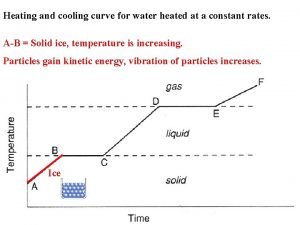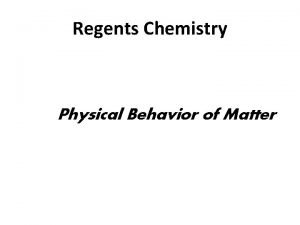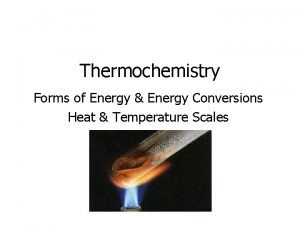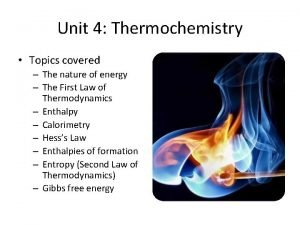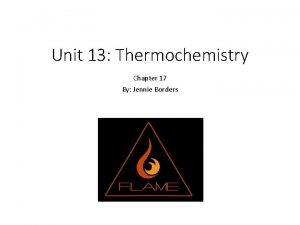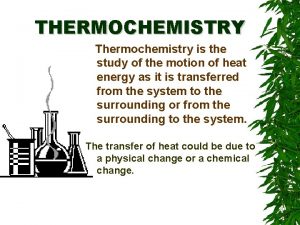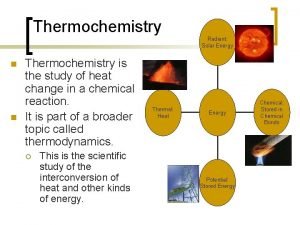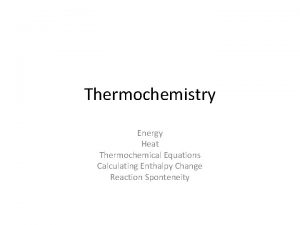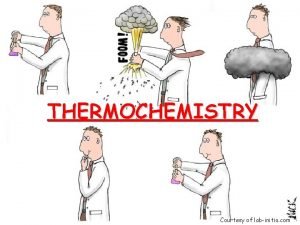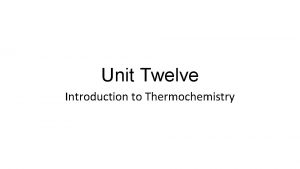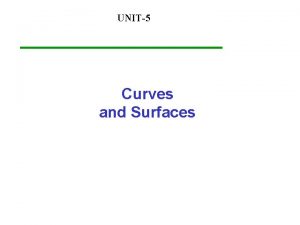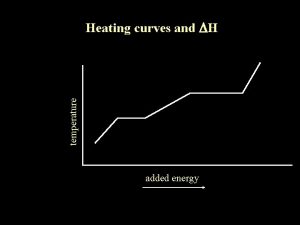THERMOCHEMISTRY Day 4 Enthalpy and Heating Curves ENTHALPY



















- Slides: 19

THERMOCHEMISTRY Day 4 Enthalpy and Heating Curves

ENTHALPY CHANGE (∆H) The amount of energy absorbed or released as heat by a system when the pressure is constant.

ΔH = Potential Energy ENDOTHERMIC ENTHALPY CHANGE Reaction Coordinate

ΔH = Potential Energy EXOTHERMIC ENTHALPY CHANGE Reaction Coordinate

Endothermic Exothermic Energy is absorbed Energy is released +q & +ΔH -q & -ΔH Break bonds Form bonds Energy appears in reactants (before the arrow) Energy appears in products (after the arrow)

Endothermic Exothermic 3 examples of the SAME information: NH 3 + H 2 O NH 4+ + OH- ΔH = +92 k. J N 2 + 3 H 2 2 NH 3 ΔH = -324 k. J positive = add(+) to reactants negative = add(+) to products energy + NH 3 + H 2 O NH 4+ + OH- N 2 + 3 H 2 2 NH 3 + energy 92 k. J + NH 3 + H 2 O NH 4+ + OH- N 2 + 3 H 2 2 NH 3 + 324 k. J

HEAT OF REACTION (or enthalpy of reaction) is the energy involved in a chemical reaction. heat of the reaction = [the sum of the heats of formation of the products] – [the sum of the heats of formation of the reactants]

THERMOCHEMICAL EQUATION chemical equation that includes the enthalpy change (the energy value) Coefficients represent the number of moles.

HEAT OF FORMATION ΔH o f is called the heat of formation § Tells us how much energy was absorbed or gained to make 1 mole of that compound § Example: water (liquid) has a ΔH o f = -286 k. J/mol Elements in their natural state will have ∆H 0 f of zero.

ENERGY: PHASE CHANGES AND HEAT CURVES Change of physical state is also called a phase change. The temperature of a substance does not change during a phase change.

PHASE CHANGES 1. Melting – Phase change from a solid to a liquid. § Molecules speed up, move farther apart, and absorb heat energy. ENDO 2. Freezing– Phase change from a liquid to a solid. § Molecule slow down, move closer together and release heat energy. EXO

PHASE CHANGES 3. Vaporization - Phase change from a liquid to a gas. § Molecules speed up, move farther apart, and absorb heat energy. ENDO 4. Condensation– Phase change from a gas to a liquid. § Molecule slow down, move closer together and release heat energy. EXO

PHASE CHANGES 5. Sublimation– Phase change from a solid to a gas. Molecules speed up, move farther apart, and absorb heat energy. ENDO 6. Deposition– Phase change from a gas to a solid. Molecules slow down, move closer together and release heat energy. EXO

HEATING CURVES Heating/Cooling Curve shows energy changes. All matter follows curve when energy is added or lost.

LABEL THE HEATING CURVE FOR WATER 100°C

LABEL THE HEATING CURVE FOR WATER s a g 100°C condensation liq ui d vaporization melting 0°C d i l so freezing

HEATING CURVES Horizontal portions of curve indicate a physical state change. Notice temperature remains constant. However, there is a change in particle position resulting in a change in potential energy.

HEATING CURVES Slope portions show temperature change which indicates a change in kinetic energy as well.

PRACTICE PROBLEMS! ON YOUR PAPER!
 Day 1 day 2 day 3 day 4
Day 1 day 2 day 3 day 4 Difference between induction heating and dielectric heating
Difference between induction heating and dielectric heating Cooling curve diagram
Cooling curve diagram Physical behavior of matter heating and cooling curves
Physical behavior of matter heating and cooling curves Physical behavior of matter heating and cooling curves
Physical behavior of matter heating and cooling curves Heating curve
Heating curve Solid to liquid endothermic or exothermic
Solid to liquid endothermic or exothermic Heating curve graph
Heating curve graph Day 1 day 2 day 817
Day 1 day 2 day 817 Thermochemistry intro and joule conversions
Thermochemistry intro and joule conversions Romeo and juliet timeline with quotes
Romeo and juliet timeline with quotes Gibbs free energy unit
Gibbs free energy unit Chapter 17 thermochemistry practice problems answers
Chapter 17 thermochemistry practice problems answers Thermochemistry is the study of *
Thermochemistry is the study of * Thermochemistry is the study of
Thermochemistry is the study of Thermochemical equation
Thermochemical equation Introduction to thermochemistry
Introduction to thermochemistry Gaussian thermochemistry
Gaussian thermochemistry Thermochemistry formulas
Thermochemistry formulas Thermochemistry cartoon
Thermochemistry cartoon


